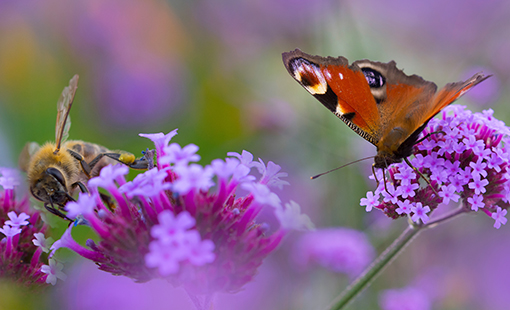
Pollinator FAQs
Bees, bats, birds and butterflies do us an important service: As they visit flowers to feed on nectar, they carry pollen from plant to plant. This movement of pollen from a flower’s male stamen to its female stigma — or that of the next flower — fertilizes plants and produces fruits and seeds.
Most of the world’s flowering plants and crops depend on the hard-working insects and birds we call pollinators.
Without pollinators, we would miss out on many fruits, vegetables and nuts — not to mention chocolate and coffee.
But pollinators are in trouble.
Threats to Pollinators
For the past 25 years, many species of bees and other pollinators have experienced large drops in numbers. Among the causes:
- Fewer places to feed and breed. Pollinator habitat is shrinking. As roads and developments have replaced meadows and wildlands, pollinators have lost feeding and nesting sites. Remaining patches of prairie and meadow have become more disconnected. That makes it harder for pollinators to reach new breeding sites or find better habitat.
- Imported species and diseases. Invasive plants crowd out native ones, reducing food and shelter for pollinators. Disease-causing organisms— including viruses, fungi and bacteria — can spread from non-native to native pollinators. Other stressors, such as poor nutrition and pesticide exposure, may intensify the effect of diseases.
- Pesticides. While pesticides can help control crop pests and invasive species, improper use can harm pollinators and other wildlife. Use pesticides only when necessary. Use the minimum amount required and target the application so that only the intended pest is affected.
- Climate change. Flowers are blooming earlier as temperatures warm, costing some pollinators the opportunity to feed. Some insects feed only on specific plants; if these blooms die before insects arrive, the insects go hungry and fewer plants get pollinated. Rising temperatures may be contributing to a decline in bumblebees. Numbers of North American bumblebees have fallen nearly 50 percent since 1974. The biggest losses have occurred in places where temperatures have risen the highest. Other climate change effects — more flooding, shorter fire cycles and the spread of invasive species — threaten native habitats. This may directly affect pollinators if the host plant that a pollinator needs to survive is overtaken by another plant species.
How You Can Help
Here are some simple things you can do to help pollinators.
1) Plant a Pollinator Garden
To attract a variety of pollinators, include a selection of plants native to your region. Native milkweed is vital for monarch butterflies to grow, develop and reproduce. Check field guides to find out which plants local caterpillars eat. Find pollinator-friendly plants for your area. Contact your local or state native plant society for help. Your local agricultural extension service is also a good resource.
Other resources for native plants include the Lady Bird Johnson Wildflower Center, with lists of native plant suppliers and a resident horticulturalist to answer questions.
2) Provide Pollinator Nesting Habitat
Pollinators such as bees and hummingbirds need places to nest as well as plants to feed on. Creating these places is surprisingly easy. Overlook some bare patches at the edge of your lawn. Many native bees are ground nesters. They need well-drained bare soil to create burrows.
Other native bees are cavity nesters; they make their homes in dead wood or brush. Leave plant stems, fallen logs or stumps for bees, beetles and flies to use for nesting. Allow some twigs and leaf litter to remain where they fall to provide overwinter shelter for many insect pollinators.
3) Avoid or Limit Pesticide Use
Make pesticides your option of last resort in battling weeds and crop and garden pests. Try these steps first.
- Take no action and accept some pest damage.
- Use physical controls. Hand-remove or trim pest-infested plants, or remove weeds and insect pests with garden gloves.
- Use mechanical controls such as machine tilling, aerating, cutting or digging.
- Cultivate healthy growing habits. Use clean weed-free and insect-free mulch. Create beneficial insect habitat. Rotate garden crops from year to year. Water the garden as needed, not on a schedule. Choose plants that have not been treated with pesticides.
- Grow organically to encourage native pest predators such as lacewings and lady beetles.
Information courtesy of FWS.gov

 Adams Fairacre Farms
Adams Fairacre Farms